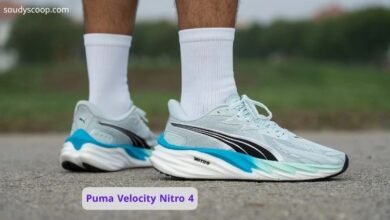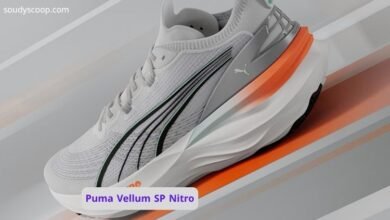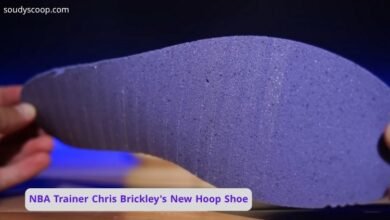Puma Fast R3 Review: The Science Behind the Fastest Running Shoe
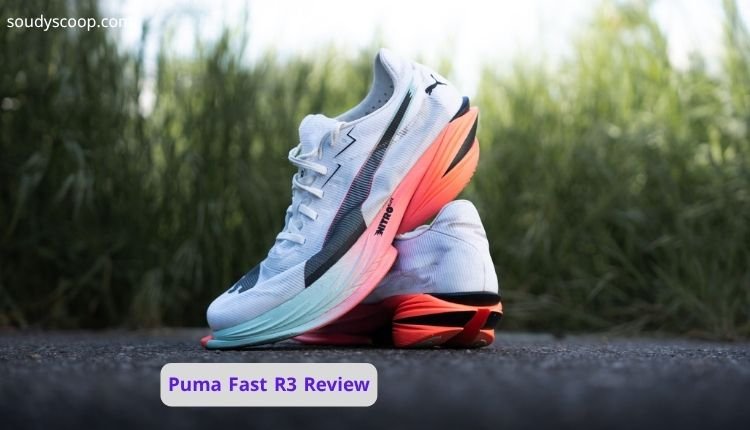
As a lifelong runner, I’ve always been fascinated by how technology continues to push the limits of human performance. When I first heard about the Puma Fast R3, a shoe claimed to be faster and more efficient than even the Nike Alphafly 3, I knew I had to test it myself.
Table of Contents
This wasn’t just another “feel-good” review—it was a scientific test conducted at Puma’s American offices in Boston, complete with a running economy study comparing the two shoes head-to-head.
In this detailed Puma Fast R3 review, I’ll walk you through the entire experience—from the lab setup and performance results to how this shoe actually feels during a marathon-level run. The data doesn’t lie, and what we found might just change the way you look at marathon footwear forever.
The Experiment: Testing Speed and Efficiency
To truly understand the Puma Fast R3, we had to put it through a scientific test. The focus was on running economy, which measures how much energy a runner uses at a given pace. Simply put, the shoe that requires less energy to maintain the same speed is the more efficient one.
The Setup
At Puma’s lab in Boston, the test protocol was straightforward but rigorous:
- 10-minute warm-up run on the treadmill.
- Three intervals of running in each shoe: five minutes of running followed by five minutes of rest.
- Two shoes tested: Puma Fast R3 vs Nike Alphafly 3.
- Oxygen and carbon dioxide levels measured to determine energy expenditure.
This alternating setup—run, rest, switch shoes, and repeat—ensured accuracy. After each round, Puma’s scientists compared oxygen consumption (VO₂) and carbon dioxide output (VCO₂) to calculate which shoe improved efficiency.
First Impressions: Light, Sleek, and Built for Speed
The moment I picked up the Puma Fast R3, one thing stood out—it’s unbelievably light. Weighing in at just 170 grams, it felt like holding air. Puma has always nailed colorways, but the Fast R3’s design took things to another level. The sleek aerodynamic silhouette screamed “speed” even before stepping onto the treadmill.
During the warm-up, the foam felt incredibly responsive—soft enough to absorb impact yet springy enough to launch me forward. Every stride felt like barely touching the ground, almost like running on a cushion of energy.
Running Feel: Effortless Motion and Pure Responsiveness
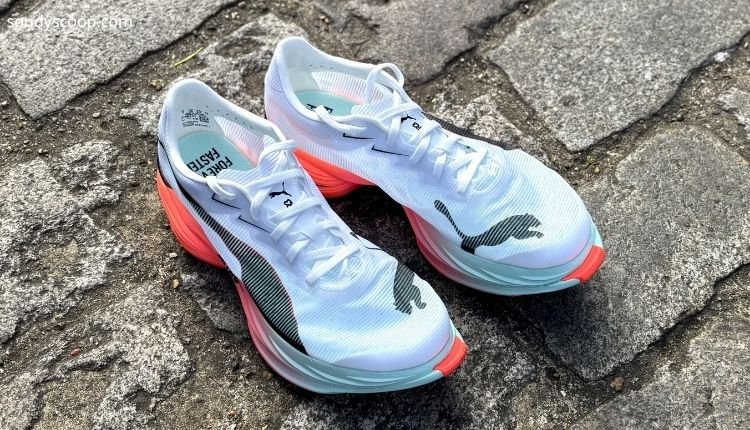
Once the test began, I immediately noticed how effortless it felt to maintain my usual 8-minute-mile pace. The Nitro Elite foam, Puma’s high-performance midsole compound, seemed to do most of the work for me. Each step provided powerful energy return without feeling overly bouncy or unstable.
When I switched to the Nike Alphafly 3, I could instantly feel the difference. Despite being an excellent shoe in its own right, it demanded noticeably more effort from my legs. The Fast R3 simply felt smoother and more efficient at the same pace.
Even before seeing the data, I could feel which shoe was winning the test.
“Read Also: Best Puma Sneakers“
The Science: Data-Backed Efficiency
After completing all six running intervals, it was time for the results. The scientists presented the data visually—with efficiency curves for both shoes—and the verdict was clear.
Key Findings:
- Puma Fast R3 improved running economy by 2.63% compared to the Nike Alphafly 3.
- Even my least efficient run in the Fast R3 outperformed my best run in the Alphafly.
- Based on my marathon PR (2:43), this efficiency translates to a potential time of 2:39:45—a full three minutes faster.
To put this into perspective, Puma’s lab and external university studies have found runners to be 3–3.5% more efficient on average in the Fast R3 compared to other elite marathon shoes. In distance running, such numbers are massive. A 2–3% gain can mean the difference between finishing strong and hitting the wall.
Breaking Down the Technology
Nitro Elite Foam: The Heart of Performance
The Nitro Elite foam used in the Fast R3 is the key to its exceptional energy return. With an energy efficiency rating of around 93%, it absorbs impact while giving almost all of that energy back into your next stride. It’s lightweight yet durable, designed to maximize propulsion without compromising comfort.
Advanced Carbon Plate Geometry
Sandwiched within the foam is a redesigned carbon plate, sculpted to optimize forward motion. Its unique curvature allows smoother toe-off transitions, helping you maintain rhythm and speed throughout long runs.
Dual Density Midsole Design
Puma tweaked the midsole with slightly different foam formulations across zones, giving extra firmness where you need stability and softness where cushioning is crucial. This hybrid setup provides a perfect balance between control and responsiveness.
Breathable Upper Construction
Beyond the midsole, Puma didn’t ignore comfort. The upper is ultra-breathable, hugging your foot without feeling restrictive. It enhances ventilation while reducing unnecessary weight—ideal for marathon conditions.
“Read Also: NBA Trainer Chris Brickley’s New Hoop Shoe“
Real-World Implications: What Efficiency Really Means
A 2.63% improvement may sound small, but in marathon running, it’s game-changing. Let’s break it down with examples:
- For a 2:45 marathoner, that’s about 3 minutes faster.
- For a 3:30 marathoner, it could save 5–6 minutes.
- For a 4-hour runner, it could cut 10–15 minutes off their finish time.
That’s purely from energy efficiency—without any change in training, nutrition, or pacing strategy.
This is why shoe innovation matters. As foam technology and biomechanics evolve, runners can push their limits without extra effort. The Fast R3 is not just faster—it’s smarter.
Comparison: Puma Fast R3 vs Nike Alphafly 3
| Feature | Puma Fast R3 | Nike Alphafly 3 |
|---|---|---|
| Weight | 170g | 210g |
| Foam Type | Nitro Elite | ZoomX |
| Energy Return | 93% | ~88% |
| Plate Design | Curved carbon propulsion plate | Full-length carbon plate |
| Efficiency Gain | +2.63% (vs Alphafly) | Baseline |
| Comfort Level | Balanced cushioning and bounce | Softer, less stable |
| Release Date | April 2025 (Boston Marathon) | 2024 |
From lab data and subjective feel alike, the Fast R3 edges out the Alphafly 3 in overall performance. It’s lighter, firmer, and better at energy recycling—especially over longer distances.
Who Is the Puma Fast R3 For?
While elite athletes will benefit most from the Fast R3’s marginal gains, Puma designed it for all serious marathoners. Whether you’re chasing a sub-3-hour finish or simply aiming to break your personal best, this shoe delivers measurable results.
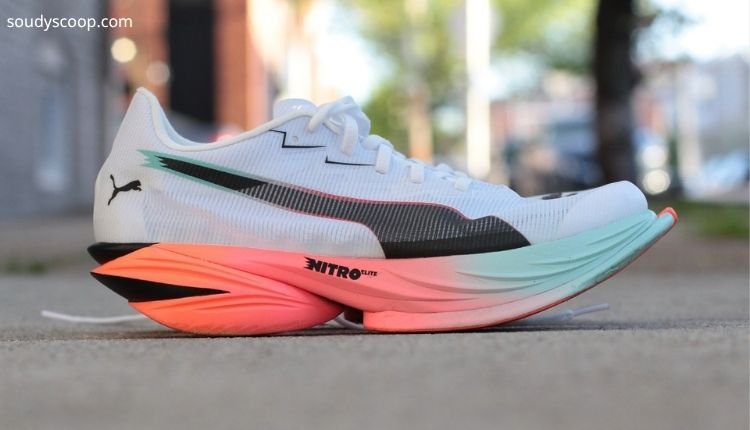
- Beginner runners will love the reduced fatigue thanks to the foam’s rebound.
- Intermediate runners will notice better pacing and endurance over long runs.
- Advanced runners will appreciate the precision and responsiveness under high load.
The shoe’s versatility makes it suitable not only for racing but also for tempo runs, long workouts, and even light interval training.
“Read Also: Puma Hali 1 Review“
The Experience: Running Beyond the Lab
After leaving the Puma Nitro Lab, I took the Fast R3 for several outdoor runs to see how it performs outside controlled conditions. The results were equally impressive. Uphill segments felt smoother, and my cadence remained steady with less perceived effort. Even on longer routes, my legs felt fresher than usual after 15–20 kilometers.
The shoe’s stability was another pleasant surprise. Despite being ultralight, it never felt wobbly or unstable on uneven terrain. Puma clearly found the sweet spot between minimalism and control.
Durability and Comfort
One might assume such a light shoe would compromise durability, but that’s not the case here. After roughly 100 miles of mixed running, the midsole showed minimal compression, and the outsole remained grippy. The upper’s mesh construction held up perfectly with no signs of tearing.
Comfort-wise, the Fast R3 continues to impress. It fits true to size, with a snug midfoot hold and slightly roomy toe box—perfect for long-distance comfort. The heel collar locks securely without irritating the Achilles tendon.
Price and Release Date
The Puma Fast R3 will officially launch during the Boston Marathon weekend in April 2025. Pricing hasn’t been confirmed yet, but expect it to align with other super shoes, likely around $250–$275 USD.
Considering its technological leap and lab-backed performance gains, that price feels justified for anyone chasing serious running goals.
“Read Also: Nike Running Shoe“
Pros and Cons of Puma Fast R3
Pros:
- Exceptional energy return (93%)
- Proven 2.63%+ efficiency gain
- Ultralight build at 170g
- Balanced stability and cushioning
- Scientifically tested in real conditions
- Ideal for marathons and tempo runs
Cons:
- Premium price point
- Limited availability at launch
- Not ideal for casual runners or recovery days
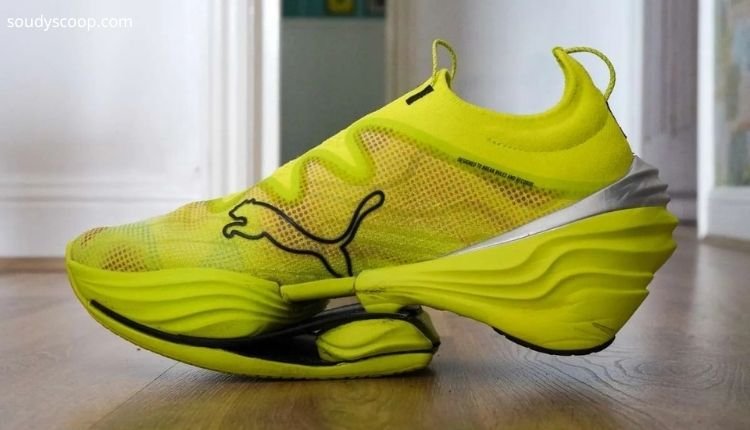
Final Verdict
After extensive lab testing and real-world miles, one conclusion is clear: the Puma Fast R3 isn’t just another running shoe—it’s a performance breakthrough. Combining scientific validation with elite design, it outperforms its toughest competitor, the Nike Alphafly 3, by delivering greater efficiency, better propulsion, and lighter weight.
For runners serious about breaking their personal records or shaving precious minutes off marathon times, this shoe is an undeniable advantage. Puma has proven that innovation isn’t just about aesthetics—it’s about making every stride count.
Conclusion: Puma Fast R3 Review
The Puma Fast R3 represents the next frontier in running technology. With lab-tested proof of superior efficiency and a design engineered for both comfort and speed, it’s clear that Puma has set a new standard for marathon footwear.
Whether you’re a competitive runner or an enthusiast chasing your next PR, the Fast R3 gives you a scientifically proven edge. The future of fast has arrived—and it’s wearing a Puma logo.
As a dedicated footwear reviewer, I have spent years analyzing and testing athletic shoes across every category, from high-performance running sneakers to lifestyle-inspired basketball silhouettes. My work goes beyond simple first impressions; each review is built on a foundation of hands-on experience, thorough research, and attention to the details that matter most to athletes and casual wearers alike. I aim to bridge the gap between brands’ marketing claims and real-world performance, giving readers an honest, balanced perspective.
My writing style combines technical evaluation with an accessible tone, so both professionals and everyday enthusiasts can understand the strengths and weaknesses of each shoe. Whether discussing midsole cushioning technology, outsole traction, or upper material breathability, I break down complex features into practical insights. Readers trust my reviews because they know I highlight both the benefits and potential drawbacks, helping them make more confident purchasing decisions.
Over time, my work has evolved into a comprehensive resource for anyone seeking guidance on athletic footwear. I regularly compare new releases with previous models to highlight improvements or missed opportunities, while also exploring how different shoes fit specific activities—such as marathon training, weightlifting, or casual streetwear. By staying updated with industry trends and listening to community feedback, I ensure that my reviews remain relevant, informative, and genuinely useful.
Ultimately, my mission is to provide clarity in a crowded market. With countless options available, choosing the right pair of shoes can feel overwhelming. Through in-depth, unbiased, and engaging reviews, I strive to make that decision easier, equipping readers with the knowledge they need to find footwear that truly matches their performance goals and personal style.
